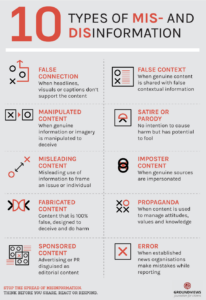By Caterina Valentino
Caterina Valentino highlights how we can stay vigilant in the face of information warfare.

Wars are not always fought on the ground by armed military forces. Communications and public relations (PR) practitioners are constantly fighting a war for the truth. The truth can have multiple sides that we perceive through our own biases and understandings so how do we determine which one wins?
The battlefield of information warfare is subtle, it revolves around information and technology. It’s relegated to sleight of hand communications, doctored images, podcasters selling snake oil, and mixed messaging.
Three Principles of Information Warfare
Before the PR war can be won, the rules of engagement need to be understood.
There are three principles of information warfare:
- The goal of information warfare is to affect an adversary’s messaging and information systems with the aim to leverage, protect, promote, and amplify one’s own message. As fake as it may be.
- The battlefield of information warfare comprises pictures, texts, advertisements, endorsements, and media content that causes one to pause and reconsider what is the truth.
- The win in information warfare is subtle. It’s the creation of a smoke and mirror illusion that an inaccurate view of a situation is the truth. PR practitioners, this is the enemy.
The Weaponry
Information warfare’s prime directive is to undermine the opponent and get the upper hand. This can be achieved through:
- Misinformation – misleading information created or shared without the intent to manipulate people. An example would be innocently sharing a rumor about your favourite celebrity, without checking if it’s true or false.
- Disinformation – deliberate attempts to confuse or manipulate people with dishonest information.
- Hoaxes – a widely publicized false information designed to invite reflexive, unthinking acceptance and gull its victims into putting up the highest possible social currency in its support. For example, the person responsible for the celebrity-death story has created a hoax.
Learn more about the types of mis- and dis- information from the graphic below:

Counterattack – Navigating the Fog of Misinformation
Misinformation isn’t going away. While social media platforms have been taken to task to curb misinformation being broadcast, no method has been completely successful at removing all misleading content from the web. This is why we have to build our defenses up.
Here are a few suggestions that help me stay vigilant and successfully navigate information online:
Educate yourself
Inoculation against misinformation through education allows one to readily identify the tricks that agents of disinformation use. Education may include proactive research online and gamification exercises. Some resources I recommend to bookmark are:
- Go-Viral created with support from the UK Government, the WHO, and the United Nations to specifically combat COVID-19 misinformation.
- Cranky Uncle that helps build resilience against misinformation about climate change.
- Quick start guide to fact finding.
- Reverse image search.
I also recommend checking your alma mater for dashboards of curated facts that indicate the truth worthiness of social media outlets. Anatoliy Gruzd, Canada Research Chair in Privacy Preserving Digital Technologies, and Philip Mai, a fellow researcher at Ryerson’s Social Media Lab, developed two dashboards that separate truth from the noise, one for Covid-19 and one for the war in Ukraine
Recognize your own biases
Research demonstrates people are more gullible to misinformation that aligns with their biases. Confirmation bias is the tendency to search for, interpret, favor, and recall information that confirms or supports one’s beliefs or values. Learn more at Rate Your Bias.
Consider the Source
Play the online game Fakey to learn your media literacy level and how susceptible you are to misinformation. Double check the credibility of stories by reading widely and from different media outlets. Be on the lookout for fake news sites. Check the URL extension. Right click to view the page’s source code.
Remember there are bots tweeting hundreds of times a day, day and night, on a specific topic cogging cyberspace with misinformation.
Pause before you share
Lisa Fazio has found that when subjects were asked to pause and consider why a headline is true or false, they felt less likely to share false information.
Be Aware of Your Emotions
Anger and anxiety make one vulnerable to falling for misinformation. Be mindful and critical of the information you share.
See Something Say Something
Stand up to misinformation publicly. Unchecked misinformation spreads fast and, just like the sales pitches of the snake oil salesperson, embeds fake illusions into the minds of those who are more susceptible to believe in it.
It may be uncomfortable but callout misinformation, especially if it’s someone you know spreading it. Use sites such as Snopes to fact-check the information and alert others to misinformation.
Calling out incidents of misinformation and amplifying that a message is fake generates counterarguments against misinformation and the tactics of fear mongering, conspiracy theories, impersonating experts, polarization, trolling and discrediting. Expose signals to others to look more closely before choosing to share information; and even if you don’t discourage the original poster, you’re discouraging others.
As misinformation and disinformation grows in this increasingly digitalised world, remember the powerful quote from one of Hogwarts’ greatest Defense Against the Dark Arts professors – Severus Snape: “Our defenses must be as flexible and inventive as the arts we seek to undo.”
By Cassandra Cleveland As a new mom and communications professional, returning to work after maternity leave brought a wave of mixed emotions. The excitement of rejoining the professional realm was tempered by the realization that the communications landscape had evolved during my time away, leaving me with a potential knowledge gap. Determined to bridge […] By Linda Bicho-Vachon I’ve always been a learner. In my former role, I completed my association’s certification program and stayed updated by attending industry seminars. The certification demonstrated that I had the skill and expertise to do my job and gave me confidence to grow my career. When I decided to transition to a […] By Prachi Shailendra As a communications professional who embarked on the Canadian journey in 2019 with over six years of international experience in corporate communications, I vividly recall the challenges and triumphs of breaking into the local job market. I soon realized that for newcomers, success often hinges on more than just a polished […] By Andrea Walasek Dear Readers, It is a pleasure to introduce myself as the Editor-in-Chief of IABC/Toronto’s Communicator publication for 2023-2024. As a dedicated professional who has worked in Public Relations for over 19 years and a proud volunteer with IABC/Toronto, I am happy to bring you the Winter 2024 issue, focused on a topic […] By Matisse Hamel-Nelis Matisse Hamel-Nelis reminds us that IDEA are more than just buzzwords; they are vital principles that can transform the world of communications. In the ever-evolving world of communications, the principles IDEA are gaining increasing significance. When applied effectively, they help foster a more enriched, engaging and impactful communication environment – enhancing meaningful internal […] By Amanda Cosentino Amanda Cosentino poses the question: When you think about the word “accessibility,” what images pop up in your head? When you think about the word “accessibility,” what images pop up in your head? Perhaps a person in a wheelchair, or a reserved parking spot? But those are only small pieces of accessibility. […] (PhD, MBA, MPA) is a dynamic, people-person who practices the concepts of teamwork and collaboration. An experienced educator, health care leader, she possesses a diverse body of knowledge. Caterina is comfortable researching and writing on many topics. She completed post-graduate education in public relations, publishing, leadership, accessibility and inclusion. Contact Caterina @CaterinaLucia or caterina.l.valentino@gmail.com, or connect with her on LinkedIn @caterina-lucia-valentino.
(PhD, MBA, MPA) is a dynamic, people-person who practices the concepts of teamwork and collaboration. An experienced educator, health care leader, she possesses a diverse body of knowledge. Caterina is comfortable researching and writing on many topics. She completed post-graduate education in public relations, publishing, leadership, accessibility and inclusion. Contact Caterina @CaterinaLucia or caterina.l.valentino@gmail.com, or connect with her on LinkedIn @caterina-lucia-valentino.Return to the Spring 2022 Issue of Communicator
READ MORE
Navigating the return to work: A new mom’s journey into communications upskilling
Up your game by Upskilling
New immigrant jobseeker? What’s your strategy to success?
Letter from the Editor
The IDEA Framework: Enhancing Inclusion, Diversity, Equity & Accessibility in the Communications Profession
Three practical ways to Integrate Accessibility into Your Everyday Life